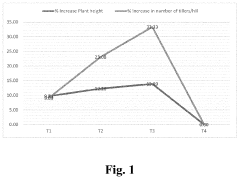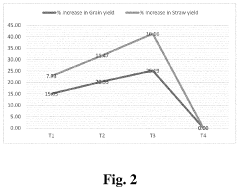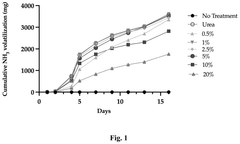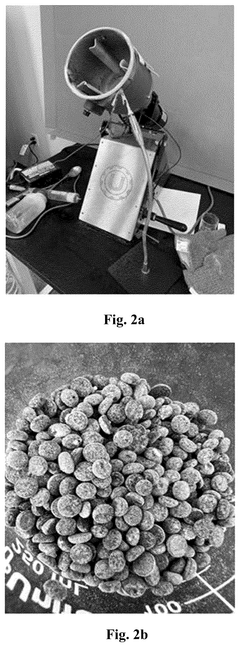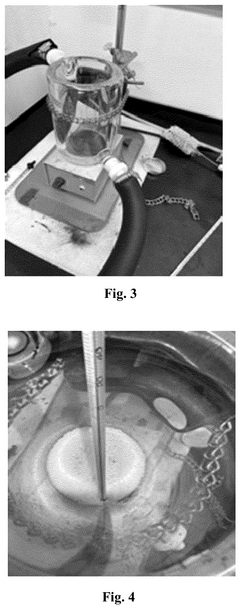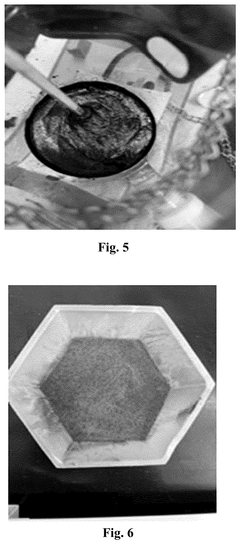Nitrous Acid in Sustainable Land Use Planning
AUG 4, 20259 MIN READ
Generate Your Research Report Instantly with AI Agent
Patsnap Eureka helps you evaluate technical feasibility & market potential.
Nitrous Acid Research Background and Objectives
Nitrous acid (HONO) has emerged as a crucial component in atmospheric chemistry and its role in sustainable land use planning has gained significant attention in recent years. The study of nitrous acid is rooted in the broader context of nitrogen cycle research, which has been a focus of environmental science for decades. As urbanization and agricultural intensification continue to alter landscapes globally, understanding the dynamics of nitrous acid in various ecosystems has become increasingly important for developing sustainable land management practices.
The evolution of nitrous acid research can be traced back to early atmospheric studies in the mid-20th century. However, it was not until the late 1990s and early 2000s that scientists began to recognize its significant impact on air quality, particularly in urban environments. This realization sparked a surge of research aimed at understanding the sources, sinks, and chemical behavior of HONO in different environmental settings.
In the context of sustainable land use planning, the objectives of nitrous acid research have expanded beyond atmospheric chemistry to encompass soil science, agricultural management, and urban planning. The primary goal is to elucidate the role of HONO in nitrogen cycling within terrestrial ecosystems and its implications for land use decisions. This includes investigating how different land use types affect HONO formation and emission, as well as how HONO influences soil fertility, plant growth, and air quality.
One of the key aims of current research is to develop comprehensive models that can predict HONO dynamics across various land use scenarios. These models are essential for informing policy decisions and guiding sustainable land management practices. Additionally, researchers are working to identify strategies for mitigating HONO emissions from agricultural and urban sources while maximizing its beneficial effects on ecosystem productivity.
The technological advancements in measurement techniques have significantly contributed to the progress in nitrous acid research. The development of high-resolution, real-time monitoring systems has enabled scientists to capture the spatial and temporal variability of HONO concentrations with unprecedented accuracy. This has led to a more nuanced understanding of the factors influencing HONO formation and distribution in different environments.
As the field progresses, interdisciplinary collaboration has become increasingly important. Atmospheric chemists, soil scientists, ecologists, and urban planners are working together to create a holistic approach to nitrous acid research in the context of sustainable land use. This collaborative effort aims to bridge the gap between scientific understanding and practical application, ensuring that research outcomes can be effectively translated into actionable strategies for land management and policy development.
The evolution of nitrous acid research can be traced back to early atmospheric studies in the mid-20th century. However, it was not until the late 1990s and early 2000s that scientists began to recognize its significant impact on air quality, particularly in urban environments. This realization sparked a surge of research aimed at understanding the sources, sinks, and chemical behavior of HONO in different environmental settings.
In the context of sustainable land use planning, the objectives of nitrous acid research have expanded beyond atmospheric chemistry to encompass soil science, agricultural management, and urban planning. The primary goal is to elucidate the role of HONO in nitrogen cycling within terrestrial ecosystems and its implications for land use decisions. This includes investigating how different land use types affect HONO formation and emission, as well as how HONO influences soil fertility, plant growth, and air quality.
One of the key aims of current research is to develop comprehensive models that can predict HONO dynamics across various land use scenarios. These models are essential for informing policy decisions and guiding sustainable land management practices. Additionally, researchers are working to identify strategies for mitigating HONO emissions from agricultural and urban sources while maximizing its beneficial effects on ecosystem productivity.
The technological advancements in measurement techniques have significantly contributed to the progress in nitrous acid research. The development of high-resolution, real-time monitoring systems has enabled scientists to capture the spatial and temporal variability of HONO concentrations with unprecedented accuracy. This has led to a more nuanced understanding of the factors influencing HONO formation and distribution in different environments.
As the field progresses, interdisciplinary collaboration has become increasingly important. Atmospheric chemists, soil scientists, ecologists, and urban planners are working together to create a holistic approach to nitrous acid research in the context of sustainable land use. This collaborative effort aims to bridge the gap between scientific understanding and practical application, ensuring that research outcomes can be effectively translated into actionable strategies for land management and policy development.
Sustainable Land Use Market Analysis
The sustainable land use market has experienced significant growth in recent years, driven by increasing environmental concerns and the need for more efficient resource management. This market encompasses various sectors, including agriculture, forestry, urban planning, and conservation efforts. The demand for sustainable land use practices is primarily fueled by government regulations, consumer preferences for eco-friendly products, and corporate sustainability initiatives.
In the agricultural sector, there is a growing trend towards precision farming techniques that optimize resource use and minimize environmental impact. This includes the adoption of smart irrigation systems, soil health management practices, and crop rotation strategies. The market for these technologies and services is expected to expand as farmers seek to improve yields while reducing their ecological footprint.
Urban planning is another key area within the sustainable land use market. Cities worldwide are implementing green infrastructure projects, such as urban forests, green roofs, and permeable pavements, to address issues like stormwater management and urban heat island effects. The demand for sustainable urban development solutions is particularly strong in rapidly growing metropolitan areas facing environmental challenges.
The forestry sector is witnessing increased interest in sustainable management practices, driven by both environmental concerns and economic opportunities. Sustainable forestry certifications, such as those provided by the Forest Stewardship Council (FSC), are becoming more prevalent as consumers and businesses prioritize responsibly sourced wood products.
Conservation and restoration efforts represent a growing segment of the sustainable land use market. This includes initiatives for habitat preservation, wetland restoration, and reforestation projects. The emergence of carbon credit markets has created additional economic incentives for land conservation and restoration activities.
The role of technology in sustainable land use is becoming increasingly important. Geographic Information Systems (GIS), remote sensing technologies, and data analytics are being employed to optimize land use decisions and monitor environmental impacts. These tools are essential for implementing and managing sustainable land use practices across various sectors.
Market trends indicate a shift towards integrated approaches to sustainable land use, recognizing the interconnectedness of different ecosystems and land use types. This holistic perspective is driving demand for comprehensive land management solutions that address multiple sustainability goals simultaneously.
The sustainable land use market faces challenges, including the need for significant upfront investments, regulatory complexities, and the long-term nature of many sustainability initiatives. However, the growing recognition of the economic and environmental benefits of sustainable land use practices is expected to drive continued market growth in the coming years.
In the agricultural sector, there is a growing trend towards precision farming techniques that optimize resource use and minimize environmental impact. This includes the adoption of smart irrigation systems, soil health management practices, and crop rotation strategies. The market for these technologies and services is expected to expand as farmers seek to improve yields while reducing their ecological footprint.
Urban planning is another key area within the sustainable land use market. Cities worldwide are implementing green infrastructure projects, such as urban forests, green roofs, and permeable pavements, to address issues like stormwater management and urban heat island effects. The demand for sustainable urban development solutions is particularly strong in rapidly growing metropolitan areas facing environmental challenges.
The forestry sector is witnessing increased interest in sustainable management practices, driven by both environmental concerns and economic opportunities. Sustainable forestry certifications, such as those provided by the Forest Stewardship Council (FSC), are becoming more prevalent as consumers and businesses prioritize responsibly sourced wood products.
Conservation and restoration efforts represent a growing segment of the sustainable land use market. This includes initiatives for habitat preservation, wetland restoration, and reforestation projects. The emergence of carbon credit markets has created additional economic incentives for land conservation and restoration activities.
The role of technology in sustainable land use is becoming increasingly important. Geographic Information Systems (GIS), remote sensing technologies, and data analytics are being employed to optimize land use decisions and monitor environmental impacts. These tools are essential for implementing and managing sustainable land use practices across various sectors.
Market trends indicate a shift towards integrated approaches to sustainable land use, recognizing the interconnectedness of different ecosystems and land use types. This holistic perspective is driving demand for comprehensive land management solutions that address multiple sustainability goals simultaneously.
The sustainable land use market faces challenges, including the need for significant upfront investments, regulatory complexities, and the long-term nature of many sustainability initiatives. However, the growing recognition of the economic and environmental benefits of sustainable land use practices is expected to drive continued market growth in the coming years.
Nitrous Acid Technology Status and Challenges
The current status of nitrous acid (HONO) research in sustainable land use planning reveals significant challenges and opportunities. Globally, there is a growing recognition of HONO's role in atmospheric chemistry and its impact on air quality and climate change. However, the integration of HONO considerations into land use planning remains in its infancy.
One of the primary challenges is the complex nature of HONO formation and destruction processes in the environment. While laboratory studies have provided insights into HONO chemistry, field measurements often show discrepancies between observed and modeled HONO concentrations. This gap in understanding limits the ability to accurately predict HONO levels in different land use scenarios.
The heterogeneous nature of HONO sources and sinks across various land types presents another significant challenge. Urban, agricultural, and forested areas exhibit distinct HONO dynamics, making it difficult to develop universally applicable models for sustainable land use planning. Additionally, the interplay between HONO and other atmospheric pollutants, such as nitrogen oxides and volatile organic compounds, further complicates the assessment of HONO's environmental impact.
Technological limitations in HONO measurement techniques pose a substantial obstacle. While advances have been made in real-time HONO detection methods, many current technologies suffer from interference issues or lack the sensitivity required for accurate measurements in diverse environmental conditions. This hampers efforts to establish comprehensive HONO monitoring networks essential for informed land use decisions.
The geographical distribution of HONO research presents another challenge. Most studies have been conducted in North America, Europe, and parts of Asia, leaving significant knowledge gaps in other regions. This uneven distribution of research efforts limits the global applicability of HONO-related land use strategies and highlights the need for more diverse, region-specific studies.
Despite these challenges, recent technological advancements offer promising solutions. Improved spectroscopic techniques and the development of low-cost sensor networks are enhancing our ability to monitor HONO levels across different land use types. Additionally, progress in atmospheric chemistry modeling is gradually improving our capacity to predict HONO behavior under various environmental conditions.
Interdisciplinary collaborations between atmospheric scientists, urban planners, and policymakers are emerging as a key approach to addressing the complexities of integrating HONO research into sustainable land use planning. These collaborations are fostering a more holistic understanding of the interactions between land use, air quality, and climate, paving the way for more effective and sustainable urban and rural development strategies.
One of the primary challenges is the complex nature of HONO formation and destruction processes in the environment. While laboratory studies have provided insights into HONO chemistry, field measurements often show discrepancies between observed and modeled HONO concentrations. This gap in understanding limits the ability to accurately predict HONO levels in different land use scenarios.
The heterogeneous nature of HONO sources and sinks across various land types presents another significant challenge. Urban, agricultural, and forested areas exhibit distinct HONO dynamics, making it difficult to develop universally applicable models for sustainable land use planning. Additionally, the interplay between HONO and other atmospheric pollutants, such as nitrogen oxides and volatile organic compounds, further complicates the assessment of HONO's environmental impact.
Technological limitations in HONO measurement techniques pose a substantial obstacle. While advances have been made in real-time HONO detection methods, many current technologies suffer from interference issues or lack the sensitivity required for accurate measurements in diverse environmental conditions. This hampers efforts to establish comprehensive HONO monitoring networks essential for informed land use decisions.
The geographical distribution of HONO research presents another challenge. Most studies have been conducted in North America, Europe, and parts of Asia, leaving significant knowledge gaps in other regions. This uneven distribution of research efforts limits the global applicability of HONO-related land use strategies and highlights the need for more diverse, region-specific studies.
Despite these challenges, recent technological advancements offer promising solutions. Improved spectroscopic techniques and the development of low-cost sensor networks are enhancing our ability to monitor HONO levels across different land use types. Additionally, progress in atmospheric chemistry modeling is gradually improving our capacity to predict HONO behavior under various environmental conditions.
Interdisciplinary collaborations between atmospheric scientists, urban planners, and policymakers are emerging as a key approach to addressing the complexities of integrating HONO research into sustainable land use planning. These collaborations are fostering a more holistic understanding of the interactions between land use, air quality, and climate, paving the way for more effective and sustainable urban and rural development strategies.
Current Nitrous Acid Detection Methods
01 Production and synthesis of nitrous acid
Nitrous acid can be produced through various chemical processes, including the reaction of nitrogen oxides with water or the reduction of nitric acid. These methods are often used in industrial settings for the large-scale production of nitrous acid and its derivatives.- Production and synthesis of nitrous acid: Nitrous acid can be produced through various chemical processes, including the reaction of nitrogen oxides with water or the reduction of nitric acid. The synthesis methods often involve careful control of temperature and pressure to optimize yield and purity.
- Applications in industrial processes: Nitrous acid finds applications in various industrial processes, such as metal etching, dye manufacturing, and as a reagent in organic synthesis. It is also used in the production of certain chemicals and pharmaceuticals.
- Environmental impact and waste treatment: The use and disposal of nitrous acid can have environmental implications. Proper waste treatment methods are necessary to neutralize or convert nitrous acid into less harmful compounds before release into the environment. This may involve chemical treatments or specialized disposal techniques.
- Analytical methods for detection and quantification: Various analytical techniques are employed for the detection and quantification of nitrous acid in different matrices. These may include spectrophotometric methods, electrochemical sensors, or chromatographic techniques, allowing for accurate measurement in environmental, industrial, or research settings.
- Safety considerations and handling procedures: Due to its corrosive and potentially hazardous nature, specific safety measures and handling procedures are required when working with nitrous acid. This includes proper storage, use of protective equipment, and implementation of safety protocols to prevent accidents and exposure.
02 Applications in surface treatment and etching
Nitrous acid and its compounds are utilized in surface treatment processes, particularly for etching and modifying metal surfaces. This application is common in the manufacturing of electronic components and in the preparation of materials for various industrial uses.Expand Specific Solutions03 Environmental and atmospheric chemistry
Nitrous acid plays a significant role in atmospheric chemistry, particularly in the formation of smog and acid rain. Research in this area focuses on understanding the reactions of nitrous acid in the atmosphere and its impact on air quality and environmental processes.Expand Specific Solutions04 Use in chemical analysis and detection
Nitrous acid and its derivatives are employed in various analytical techniques for the detection and quantification of chemical compounds. This includes applications in environmental monitoring, quality control in industrial processes, and scientific research.Expand Specific Solutions05 Safety and handling of nitrous acid
Due to its corrosive and reactive nature, special considerations are required for the safe handling, storage, and disposal of nitrous acid. This includes the development of specialized equipment, safety protocols, and neutralization techniques to mitigate risks associated with its use in industrial and laboratory settings.Expand Specific Solutions
Key Players in Nitrous Acid Research
The research on nitrous acid in sustainable land use planning is in an emerging phase, with growing interest due to its environmental implications. The market size is expanding as more organizations recognize the importance of sustainable land management practices. Technologically, the field is still developing, with varying levels of maturity among key players. Companies like BASF Corp. and Bayer CropScience LP are leveraging their extensive chemical expertise to advance research in this area. Academic institutions such as Nanjing Agricultural University and University of Florida are contributing significant research efforts. Collaborative initiatives between industry and academia, exemplified by partnerships involving organizations like Ceres and Plant Bioscience Ltd., are driving innovation in sustainable land use technologies incorporating nitrous acid considerations.
Nanjing Agricultural University
Technical Solution: Nanjing Agricultural University has developed innovative approaches for studying nitrous acid in sustainable land use planning. Their research focuses on the role of nitrous acid in soil nitrogen cycling and its impact on agricultural productivity. They have implemented advanced spectroscopic techniques to measure nitrous acid concentrations in soil and air with high precision[1]. The university has also developed models to predict nitrous acid formation and decomposition under various environmental conditions, which aids in optimizing fertilizer application and reducing nitrogen losses[2]. Their work includes field experiments across different soil types and climatic zones to validate these models and provide practical recommendations for sustainable land management practices[3].
Strengths: Comprehensive approach combining laboratory and field studies; development of predictive models. Weaknesses: May be limited to agricultural contexts; potential challenges in scaling up to diverse global environments.
Institute of Geographic Sciences and Natural Resources Research
Technical Solution: The Institute has pioneered research on nitrous acid's role in sustainable land use planning, focusing on its interactions with various ecosystems. They have developed a novel remote sensing technique to map nitrous acid concentrations across large landscapes, enabling better understanding of spatial and temporal variations[4]. The Institute has also created an integrated land use model that incorporates nitrous acid dynamics, allowing for more accurate predictions of nitrogen deposition and its environmental impacts[5]. Their approach combines geospatial analysis, atmospheric chemistry, and ecological modeling to provide a holistic view of nitrous acid's role in land use planning[6].
Strengths: Interdisciplinary approach; advanced remote sensing capabilities; large-scale applicability. Weaknesses: May require significant computational resources; potential challenges in model validation for diverse ecosystems.
Innovative Nitrous Acid Measurement Techniques
Bio-nitrogen fertilizer formulation for organic and sustainable farming
PatentPendingUS20230183144A1
Innovation
- A Bio-Nitrogen fertilizer formulation containing a combination of nitrogen-fixing microorganisms such as Azotobacter sp., Azospirillum sp., Rhizobium sp., and Gluconacetobater diazotrophicus, along with nitrogen-rich carrier materials, bentonite, and essential minerals, in liquid, powder, or granular form, to enhance nitrogen bioavailability and reduce chemical fertilizer use.
N-containing/humic fertilizer and preparing methods thereof
PatentPendingUS20250143294A1
Innovation
- A method for producing a nitrogen-containing component/humic substance fertilizer by mixing a particulate humic substance with a nitrogen-containing component, heating the mixture to form a molten fertilizer, and then forming granules through pastillation or other prilling technologies, which are subsequently cooled and optionally coated to enhance durability and controlled release.
Environmental Impact Assessment
The environmental impact assessment of nitrous acid in sustainable land use planning is a critical component of understanding the broader ecological implications of this compound. Nitrous acid (HONO) plays a significant role in atmospheric chemistry and can have far-reaching effects on air quality, soil health, and ecosystem balance.
In the context of land use planning, the presence and concentration of nitrous acid can significantly influence decision-making processes. HONO is known to be a precursor to the formation of ground-level ozone, a major air pollutant that can harm human health and vegetation. As such, areas with high HONO levels may require special consideration in zoning and development plans to mitigate potential air quality issues.
The impact of nitrous acid on soil chemistry is another crucial aspect of environmental assessment. HONO can contribute to soil acidification, potentially altering nutrient availability and microbial activity. This can have cascading effects on plant growth, crop yields, and overall ecosystem health. Land use planners must consider these factors when designating areas for agriculture, conservation, or urban development.
Water quality is also affected by nitrous acid concentrations. Runoff from areas with high HONO levels can lead to acidification of water bodies, impacting aquatic ecosystems and potentially compromising water resources. This necessitates careful planning of drainage systems and buffer zones in land use strategies to protect water quality.
The assessment must also consider the potential for HONO to interact with other pollutants and environmental factors. For instance, its role in the nitrogen cycle and its interactions with ammonia and nitrogen oxides can influence the overall nitrogen budget of an ecosystem. This has implications for biodiversity conservation and the management of sensitive habitats.
Climate change considerations are integral to the environmental impact assessment of nitrous acid. As global temperatures rise, the dynamics of HONO formation and distribution may shift, potentially exacerbating its environmental impacts. Land use planners must account for these long-term trends to ensure the resilience of their strategies.
In conclusion, a comprehensive environmental impact assessment of nitrous acid is essential for sustainable land use planning. It requires a multifaceted approach that considers air quality, soil health, water resources, ecosystem dynamics, and climate change. By thoroughly evaluating these factors, planners can develop strategies that minimize negative environmental impacts and promote long-term sustainability in land use decisions.
In the context of land use planning, the presence and concentration of nitrous acid can significantly influence decision-making processes. HONO is known to be a precursor to the formation of ground-level ozone, a major air pollutant that can harm human health and vegetation. As such, areas with high HONO levels may require special consideration in zoning and development plans to mitigate potential air quality issues.
The impact of nitrous acid on soil chemistry is another crucial aspect of environmental assessment. HONO can contribute to soil acidification, potentially altering nutrient availability and microbial activity. This can have cascading effects on plant growth, crop yields, and overall ecosystem health. Land use planners must consider these factors when designating areas for agriculture, conservation, or urban development.
Water quality is also affected by nitrous acid concentrations. Runoff from areas with high HONO levels can lead to acidification of water bodies, impacting aquatic ecosystems and potentially compromising water resources. This necessitates careful planning of drainage systems and buffer zones in land use strategies to protect water quality.
The assessment must also consider the potential for HONO to interact with other pollutants and environmental factors. For instance, its role in the nitrogen cycle and its interactions with ammonia and nitrogen oxides can influence the overall nitrogen budget of an ecosystem. This has implications for biodiversity conservation and the management of sensitive habitats.
Climate change considerations are integral to the environmental impact assessment of nitrous acid. As global temperatures rise, the dynamics of HONO formation and distribution may shift, potentially exacerbating its environmental impacts. Land use planners must account for these long-term trends to ensure the resilience of their strategies.
In conclusion, a comprehensive environmental impact assessment of nitrous acid is essential for sustainable land use planning. It requires a multifaceted approach that considers air quality, soil health, water resources, ecosystem dynamics, and climate change. By thoroughly evaluating these factors, planners can develop strategies that minimize negative environmental impacts and promote long-term sustainability in land use decisions.
Policy Framework for Sustainable Land Use
The policy framework for sustainable land use in the context of nitrous acid research plays a crucial role in guiding decision-making processes and promoting environmentally responsible practices. This framework encompasses a range of regulatory measures, incentives, and guidelines designed to balance economic development with ecological preservation.
At the national level, governments typically establish overarching policies that set the tone for sustainable land use management. These policies often include provisions for reducing greenhouse gas emissions, protecting biodiversity, and promoting soil health. In the case of nitrous acid research, specific regulations may be implemented to control nitrogen-based fertilizer application and monitor atmospheric nitrogen levels.
Regional and local authorities are responsible for translating these national policies into actionable plans tailored to their specific geographical and socio-economic contexts. This may involve zoning regulations that designate areas for agricultural, industrial, or conservation purposes, taking into account the potential impacts of nitrous acid emissions on different land uses.
Incentive programs form an essential component of the policy framework, encouraging landowners and businesses to adopt sustainable practices. These may include tax breaks for implementing nitrogen-efficient farming techniques, grants for research into nitrous acid mitigation strategies, or subsidies for the adoption of precision agriculture technologies that optimize fertilizer use.
Environmental impact assessments are often mandated within the policy framework, requiring developers and land managers to evaluate the potential effects of their activities on nitrous acid levels and overall ecosystem health. These assessments help inform decision-making processes and ensure that land use changes align with sustainability goals.
Monitoring and enforcement mechanisms are critical to the success of the policy framework. This includes regular soil and air quality testing, satellite imagery analysis to track land use changes, and penalties for non-compliance with established regulations. Advanced technologies, such as remote sensing and IoT devices, are increasingly being integrated into these monitoring systems to provide real-time data on nitrous acid levels and related environmental parameters.
Collaboration between different stakeholders is emphasized within the policy framework, recognizing that sustainable land use planning requires input from various sectors. This may involve the establishment of advisory committees comprising scientists, policymakers, industry representatives, and community leaders to guide the development and implementation of land use strategies that address nitrous acid concerns.
Education and outreach initiatives are also incorporated into the framework, aiming to raise awareness about the importance of sustainable land use practices and their relationship to nitrous acid levels. These programs target farmers, urban planners, and the general public, providing information on best practices and the latest research findings in the field of nitrous acid management.
At the national level, governments typically establish overarching policies that set the tone for sustainable land use management. These policies often include provisions for reducing greenhouse gas emissions, protecting biodiversity, and promoting soil health. In the case of nitrous acid research, specific regulations may be implemented to control nitrogen-based fertilizer application and monitor atmospheric nitrogen levels.
Regional and local authorities are responsible for translating these national policies into actionable plans tailored to their specific geographical and socio-economic contexts. This may involve zoning regulations that designate areas for agricultural, industrial, or conservation purposes, taking into account the potential impacts of nitrous acid emissions on different land uses.
Incentive programs form an essential component of the policy framework, encouraging landowners and businesses to adopt sustainable practices. These may include tax breaks for implementing nitrogen-efficient farming techniques, grants for research into nitrous acid mitigation strategies, or subsidies for the adoption of precision agriculture technologies that optimize fertilizer use.
Environmental impact assessments are often mandated within the policy framework, requiring developers and land managers to evaluate the potential effects of their activities on nitrous acid levels and overall ecosystem health. These assessments help inform decision-making processes and ensure that land use changes align with sustainability goals.
Monitoring and enforcement mechanisms are critical to the success of the policy framework. This includes regular soil and air quality testing, satellite imagery analysis to track land use changes, and penalties for non-compliance with established regulations. Advanced technologies, such as remote sensing and IoT devices, are increasingly being integrated into these monitoring systems to provide real-time data on nitrous acid levels and related environmental parameters.
Collaboration between different stakeholders is emphasized within the policy framework, recognizing that sustainable land use planning requires input from various sectors. This may involve the establishment of advisory committees comprising scientists, policymakers, industry representatives, and community leaders to guide the development and implementation of land use strategies that address nitrous acid concerns.
Education and outreach initiatives are also incorporated into the framework, aiming to raise awareness about the importance of sustainable land use practices and their relationship to nitrous acid levels. These programs target farmers, urban planners, and the general public, providing information on best practices and the latest research findings in the field of nitrous acid management.
Unlock deeper insights with Patsnap Eureka Quick Research — get a full tech report to explore trends and direct your research. Try now!
Generate Your Research Report Instantly with AI Agent
Supercharge your innovation with Patsnap Eureka AI Agent Platform!
